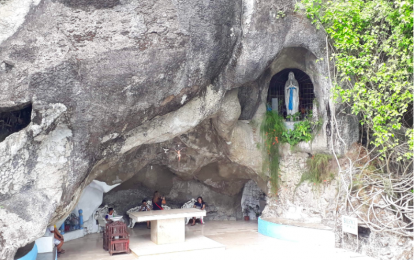
SAN JOSE DEL MONTE CITY, Bulacan -- Fifty-four years after its opening to the public, the Our Lady of Lourdes Grotto Shrine here continues to attract thousands of Catholic devotees, especially during the Holy Week, despite the blazing summer sun.
Situated 30 kilometers northeast of Manila and just beyond the boundary of Bulacan and Novaliches, a former town divided between Quezon City and Caloocan City, the grotto was opened for public veneration on the Feast of Our Lady of Lourdes on Feb. 11, 1965.
Since then, thousands of pilgrims have been flocking to the shrine to pray and offer flowers and candles to the Our Lady of Lourdes, giving thanks for prayers answered and favors received and meditating in front of the Stations of the Cross on the Rosary Hill.
The number of visitors usually peak during the Holy Week, particularly on Palm Sunday, Maundy Thursday, Good Friday, Holy Saturday, and Easter Sunday.
Marietta G. Guanzon-Holmgren, president of the Grotto Shrine Foundation Inc. (GSFI), said since 6 a.m. of Good Friday, at least 1.5 million devotees from Metro Manila and nearby Luzon provinces flocked to the shrine since Palm Sunday this year.
She was interviewed by this writer while she was overseeing the final preparations for the Good Friday procession along the Lourdes Grotto Church and Basilica complex.
The shrine was a project of religious couple, Horacio A. Guanzon and Anita Guidote-Guanzon, who hailed from known and wealthy families from Pampanga as well as Bulacan and Nueva Ecija, but they chose to make this former town and later a city as their permanent home.
According to Holmgren’s book, “The Grotto Shrine of Our Lady of Lourdes in the Philippines,” her mother Anita decided to build the grotto shrine on the family-owned 25-hectare land in the farmer barrio of Gaya-Gaya in San Jose del Monte. The same barrio is now called Barangay Graceville.
Building it was an act of thanksgiving for her mother, having been cured miraculously of cancer after a pilgrimage to the town of Lourdes in southwestern France in 1961.
The well-known story of the grotto shrine started with the Guanzon family matriarch Anita being diagnosed to have cancer of the uterus in 1961 and given by her doctors only six months to live.
She went on a pilgrimage to Lourdes, France on June 29, 1961, accompanied by her husband and one of their daughters.
She came home cured of cancer in September of the same year and lived three decades more until she died in 1990.
She left the management of the grotto to her eldest daughter, Marietta, whose attention since then has been focused on the completion of another project that was started by her parents before they died — the construction of a basilica that resembles the one in Lourdes, France.
Her father, Horacio, died on June 4, 1985 and was followed by her mother, Anita, on March 31, 1990.
The grotto shrine’s existing attractions in this city include the Calvary Hill that features 14 Stations of the Cross that portray the agony of Jesus Christ.
There are 127 statues presented in dioramas that took three years to construct, according to the book.
Behind the grotto church and basilica is a spring that is said to yield miraculous water that brings hope to those who are spiritually and physically sick.
There is also the Rosary Hill, with 155 very big beads made of concrete together weighing over eight tons and is said to be the biggest Tri-Rosary in the world.
In 1974, Irish-born Roman Catholic priest Patrick Peyton flew in to the Philippines from the United States to inaugurate the Rosary Hill.
Holmgren said the Lourdes grotto was a faithful replica of the original one in Lourdes, France.
She added that the shrine’s basilica resembles the famous basilica at Lourdes, France and cost PHP80 million.
Lourdes, a small town, is 795 kilometers south of Paris in the foothills of the Pyrenees mountains which receives more than 5 million pilgrims and tourists each year because of a set of visions reported by a young girl named Bernadette in 1858.
The Sanctuary of Our Lady of Lourdes in France incorporates 52 hectares of property and 22 places of worship, including the sacred grotto, two basilicas, and a variety of buildings for pilgrims and the sick. (PNA)
